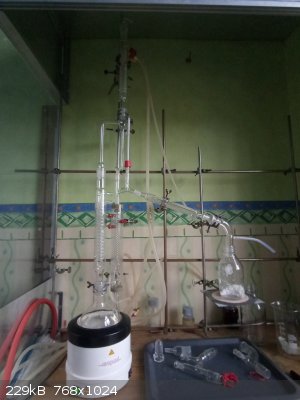teodor
National Hazard
   
Posts: 872
Registered: 28-6-2019
Location: Heerenveen
Member Is Offline
|
|
Preventing of flooding with an additional reflux attachment
Once we discussed with Fery the problem of flooding of a fractionating column. It happens, for example, when a column with a small opening (like NS
14/23) is attached to a big flask (e.g. 1L). I described to him my solution which I used and he proposed to share it on SM.
Well, maybe it would be interesting to someone, so I will do it.
The idea is to attach reflux to a second neck of the same flask and this will decrease the amount of vapors going into the column.
But this is possible only when the height of the reflux column is a bit higher than the "unfolded" size of the fractionating column.
To understand this basic principle you can do a simple experiment - take a flask with 2 necks and attach a cooler to one neck and a pipe (or a cooler
without coolant) to the second neck.
You can observe an interesting phenomenon when the point of vapor condensation in an uncooled attachment is always the same as in a cooled one. I
think it is thermodynamic lows that make this phenomenon happen. In other words, regardless of how many coolers you attached to your flask, it is
enough to enable water circulation in only one of them to make condensation happen in all of them, the cooled and uncooled ones.
But this principle plays differently when I use my Widmer column because in this column vapors go 3 times: up, down, and then up again. So, to allow
the vapors to reach the top point I need to put a condensation point (in the reflux path) at least 2 times higher. But that also means that it is
possible to regulate the flow inside fractionating column by regulating the height of the reflux attachment.
So, that solution can play as a workaround when you are in a situation of fractionating a big amount of a liquid using an undersized column.

[Edited on 5-6-2022 by teodor]
|
|
|
wg48temp9
National Hazard
   
Posts: 761
Registered: 30-12-2018
Location: not so United Kingdom
Member Is Offline
|
|
teodor:
The volume of vapour from the liquid in the flask is determined by the heating power input to the flask. So if the column is flooding, the heating
power to the flask must be reduced to reduce the volume of condensing vapor entering the column. So why use a separate condenser to reduce the flow
to the column? Was there some reason you needed vigorous boiling or do you not have a power controller on your mantel?
Unlike water vapor the vapour from boiling organics is usually denser than air so it tends to form a horizontal level in a similar way that a liquid
would. I assume that's what you describing in your simple experiment.
I am wg48 but not on my usual pc hence the temp handle.
Thank goodness for Fleming and the fungi.
Old codger' lives matters, wear a mask and help save them.
Be aware of demagoguery, keep your frontal lobes fully engaged.
I don't know who invented mRNA vaccines but they should get a fancy medal and I hope they made a shed load of money from it.
|
|
|
teodor
National Hazard
   
Posts: 872
Registered: 28-6-2019
Location: Heerenveen
Member Is Offline
|
|
No, I couldn't get fractionation without flooding by lowering the temperature. It looks like the amount of vapors is dependent on the volume of the
boiling liquid while the height of the condensation point inside a column is dependent on the temperature. So, with 1L flask and NS 14/23 Widmer and
Toluene without the reflux attachment, it was possible either to get not too hot vapors that didn't reach the top of the column or the overflow with
the liquid returned from the column which leads to flooding.
Insulation of the column also plays some role in that equation but it looks like the flooding is very easy to prevent using 250 ml flask without any
additional insulation.
I also thought that the phenomenon of the same level of vapors in all attachments is because of the communicating vessels law but in the case of the
Widmer column, it requires the reflux side to be 2 or even 3 as large, so I think it is different but still is connected with the vapor pressure.
[Edited on 6-6-2022 by teodor]
[Edited on 6-6-2022 by teodor]
[Edited on 6-6-2022 by teodor]
|
|
|